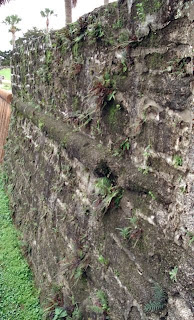The Castillo was built by the Spanish to help defend Florida. They only had one type of stone to use, coquina quarried a half mile away on Anastasia Island. For those not familiar with coquina, I liken it to a granola bar, except that shells, broken and whole, have replaced the oats. Coquina is so soft that cannonballs fired at the fort either bounced off or sank into the stone.
A botanical survey conducted in 2003 and 2004 found 56 plant species, ranging from moss to elm, growing on the coquina walls. Cyanobacteria, nematodes, fungi, and diatoms have also established themselves on the coquina. It is quite a cozy place.

A fern garden growing in coquina
The best place to see to plants is down in the moat, on hanging gardens rich in ferns, grasses, and forbs. The gardens cover the walls every 30 feet or so, wherever water drips from scuppers that drain the courtyard roof. And the plants don’t just grow outside. In one of the courtyard rooms in the 1930s, the park service used to maintain a “fern room” almost completely covered in maidenhair fern. Now only a few ferns grow in this room.

Dark, hanging gardens of the Castillo
The walls are plant rich because the coquina is shell-rich. The heterogeneous mix of shells make a Swiss cheese-like surface, where seeds can land and get established. Water also accumulates in the cavities, further turning the coquina into a nursery.
Despite the beauty of the flowers, maintenance workers at the Castillo constantly pull out the plants by hand. They don’t want the roots to get established and destroy the fort. Cleaning the walls of plants takes about six months, though of course they can’t get it all clean and little fields of color always festoon the mighty fortress.
